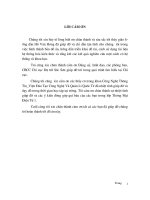Basic computing unit 3
Bạn đang xem bản rút gọn của tài liệu. Xem và tải ngay bản đầy đủ của tài liệu tại đây (456.11 KB, 13 trang )
<span class='text_page_counter'>(1)</span><div class='page_container' data-page=1></div>
<span class='text_page_counter'>(2)</span><div class='page_container' data-page=2>
<b>Lesson 5</b>
</div>
<span class='text_page_counter'>(3)</span><div class='page_container' data-page=3>
<b>Look at the picture and </b>
<b>label the components</b>
<b>expansion cards</b> <b>memory chip</b>
<b>power supply</b>
<b>hard disk </b>
<b>drive</b>
<b>floppy drive</b>
<b>motherboard</b>
<b>speaker</b>
</div>
<span class='text_page_counter'>(4)</span><div class='page_container' data-page=4>
a
b
c
d
e
f
g
h
<b>memory </b>
<b>chip</b>
<b>expansion </b>
<b>cards</b>
<b>power </b>
<b>supply</b>
<b>hard disk </b>
<b>drive</b>
<b>floppy drive</b>
<b>motherboard</b>
<b>speaker</b>
<b>processor</b>
<b>hoàng Tuấn 10</b>
</div>
<span class='text_page_counter'>(5)</span><div class='page_container' data-page=5>
1) CPU
2) Memory Slot
3) PCI Slot
4) AGP Slot
5) Power Supply Plugin
6) CMOS Battery
7) ISA Slot
8) IDE controller (hard
drive, CD-ROM)
9) CPU fan plug-in
10) PS/2 Port
(keyboard/mouse)
11) USB
</div>
<span class='text_page_counter'>(6)</span><div class='page_container' data-page=6>
<b>Reading</b>
</div>
<span class='text_page_counter'>(7)</span><div class='page_container' data-page=7>
<b>SIMM</b> <b>ROM</b>
<b>CPU</b>
<b>Cache </b>
<b>memory</b>
<b>Expansion </b>
</div>
<span class='text_page_counter'>(8)</span><div class='page_container' data-page=8>
<b>SIMMs</b>
<b>These are memory chips. The more </b>
<b>you have, the more work you can do </b>
<b>at a time. Empty memory slots </b>
<b>mean you can add more memory.</b>
<i><b>Single In-line Memory Module</b></i>
<b>- chip (n) = integrated chip = IC</b>
<b> /</b>ˈɪntɪɡreɪtɪd<b>/</b>
- <b><sub>empty (adj) /</sub></b><sub>ˈempt</sub><b><sub>/</sub></b>
- <b><sub>slot (n) </sub></b>
</div>
<span class='text_page_counter'>(9)</span><div class='page_container' data-page=9>
<b>Cache memory</b>
<b>It’s part of the memory store. It </b>
<b>has extremely fast access. It’s </b>
<b>faster than normal RAM. It can </b>
<b>speed up the computer.</b>
<b>- extremely (adv) /</b>
ɪkˈstriːmli
<b>/</b>
-
<b><sub>access (n), (v) /</sub></b>
<sub>ˈækses</sub>
<b><sub>/</sub></b>
-
<b><sub>speed up (v)</sub></b>
-
<b>RAM (Random Access Memory)</b>
</div>
<span class='text_page_counter'>(10)</span><div class='page_container' data-page=10>
<b>Expansion slots</b>
<b>These let you add features such as </b>
<b>sound or a modem to a </b>
<b>computer.</b>
<b>- add (v) </b>
<b>- feature (n) /</b>
ˈfiːtʃər
<b>/</b>
</div>
<span class='text_page_counter'>(11)</span><div class='page_container' data-page=11>
<b>ROM (Read Only Memory</b>
<b>This kind of memory contains all the </b>
<b>instructions your computer needs to </b>
<b>activate itself when you switch on. Unlike </b>
<b>RAM, its contents are retained when you </b>
<b>switch off. (constant information)</b>
<b>- contain (v) /</b>kənˈteɪn<b>/ </b><b> container (n)</b>
<b>- activate (v) /</b>ˈæktɪveɪt<b>/</b>
<b>- switch on >< switch off (v) </b>
<b>- content (n) /</b>ˈkɒntent <b>/</b>
<b>- retain (v) /</b>rɪˈteɪn<b>/</b>
</div>
<span class='text_page_counter'>(12)</span><div class='page_container' data-page=12>
Add the processor
Fit the new
motherboard
Remove the old
motherboard
Put it back together
Add the memory.
Don’t touch the
</div>
<span class='text_page_counter'>(13)</span><div class='page_container' data-page=13>
A memory cache, sometmes called a <i>cache store</i>
or <i>RAM cache</i>, is a porton of memory made of
high-speed statc RAM (SRAM) instead of the
slower and cheaper dynamic RAM (DRAM) used
for main memory. Memory caching is effectve
because most programs access the same data or
instructons over and over. By keeping as much
of this informaton as possible in SRAM, the
</div>
<!--links-->
<a href=' /><a href=' /> lập trình web với visual basic.pdf
- 229
- 825
- 0








